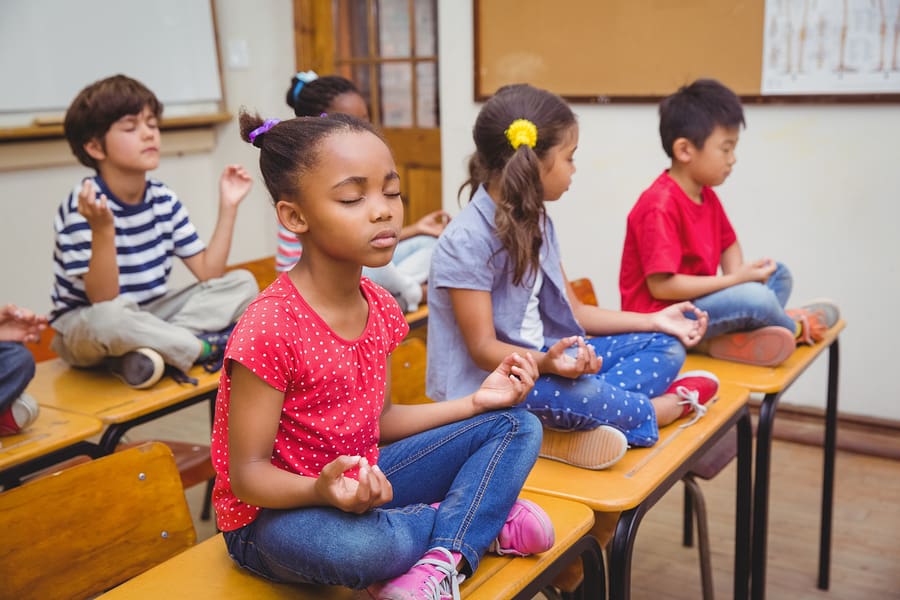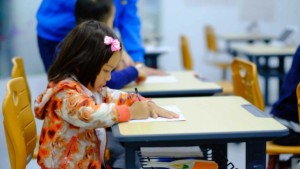Creating a Mindful Classroom Environment

By Amy Hartmann Garner, M.Ed, RYT-200
Are you stressed? These days, who isn’t? Research shows that when we experience stress our brain’s ability to think logically goes “off line” because our bodies are wired to treat stress like a threat.
You can imagine how this impacts a student’s performance in school. The social aspect of school, explorative playing and creative outlets for students have been replaced with long, exhaustive lessons and constant assessments.
Different learning environments may or may not work well for students. Some students may feel an increased level of stress working on group projects or on teams. Making sure students have the time built into the day and know how to de-stress and practice mindfulness is important. We need to help our students take a step back and teach their brains to focus on one task at a time so they are able to move forward and reach their maximum potential.
In my district, Eanes ISD in Austin, TX, we are committed to preparing and inspiring all students for life-long success. Our educators focus on teaching the whole student, which includes important life skills used outside the classroom like social-emotional learning, collaboration, communication, problem-solving, stress-management, leadership and so much more. Teaching these skills don’t only create successful students, but successful people.
This school year, we are starting to teach yoga to help our teachers and students learn how to manage stress and be more mindful in everything they do. Yoga is often perceived by the asanas or movements. However, yoga is a way of life, and the movements are just a small piece.
I use yoga and its philosophy of using the breath to teach cool-down, stress-management and test-taking strategies that take as little as five minutes and can be done right in their seats. Implementing these strategies adds a social-emotional learning aspect to any lesson and can also prevent teacher burnout.
Mindful or Mind Full?
Did you know that humans are the only species with the ability to beat ourselves up over the past and stress about the future? These two mindsets lead to a shocking number of people being diagnosed with depression and anxiety. One way to of making a more conscious effort to balance our negative thoughts and feelings is by being mindful.
I describe mindfulness as being “in the moment” and focused on one task at a time. This frame of mind has changed my life, which is why I have the burning passion to pass on my knowledge to help students and teachers across the globe.
When I tell people I’m a special education behavior support teacher, they always say something like, “It takes a special kind of person to teach those students.” The reason I was drawn to teach them is because I’m one of them. From a young age, I was quite self-aware and knew my brain was different than most of my peers. I was quite introverted as a child. Most people don’t believe me, knowing me now—I am not shy when it comes to voicing my opinion. My parents would have to force me to say hello to classmates and teachers.
At 29 years old, I was diagnosed with attention deficit disorder (ADD), testing in the 98% percentile. After achieving two master’s degrees and starting my career as a classroom teacher, I found it nearly impossible to juggle my job, home life, marriage and more. After engaging in a regimented mindfulness and meditation program, I’ve been medication-free and feel better than ever. The changes I’ve seen in myself are what drive me to share my passion to teach yoga and mindfulness in schools.
If You Can Breathe, You Can Do Yoga
Your breath is like a remote control. If you are in control of your breath, you are in control of your mind and body. I recently conducted an in-school chair yoga session with a group of teachers. I went through a series of breathing exercises, asking them to envision the stressors leaving their bodies. I also had them picture their “happy place” and send positive thoughts to others in their lives. After the session, every person in the room felt “lighter” and extremely motivated to accomplish their goals of the day.
Creating a mindful and non-stressful setting starts with the teachers. Not only do we have to manage the pressures of personalized learning, lesson-planning, teaching to the standards, grading and more, but we also have lives outside of work. Students can feel when you’re stressed, which can cause them to stress. If the teacher is in control and models the behavior of managing stress regardless of what’s thrown in front of them, students will pick up on those strategies and it will have a trickle-down effect.
Classroom Relaxation Exercises to Try Today
Sometimes we have to slow down our classrooms in order to speed up. The minutes spent taking a “time out” will save hours of off-task behavior in the long run. My tip is to start small and see what sort of impact these strategies have on your day and then share with your students.
- Sit up straight and bring your shoulders back to open up/create space in your chest. Being on computers and cell phones all the time causes us hunch over and constricts the breath.
- Your hands also carry a lot of stress, so take a moment to stretch your wrists by doing little circles or giving yourself a hand massage.
- Close your eyes for a minute and zone out. Focus on your breathing, envision your “happy place,” send positive thoughts to a loved one and take a break from the long list of to-do items.
- Breathe. It’s as easy as closing your eyes and pretending to smell a flower, and on the exhale pretending to blow out a candle. You can also try the square breathing method (inhale for a count of four, hold for four, exhale for four, hold for four); or do a few Miracle Grow breaths (start folded over, then with each breath allow yourself to rise up a little more). It may seem silly at first, but you will be surprised how good you feel afterward.
Additionally for students:
- Create a “cool-down” area for students to go when they’re feeling stressed. If they know there is a safe space specifically used to de-stress, it will naturally lower their stress levels.
- If you can tell students are stressed out, try filling an empty tissue box with cotton balls and have students count the balls. I do this one a lot because it helps students learn to focus on the task at hand, and the cotton is pleasing to their sense of touch.
So when is the best time to implement these strategies? Here’s what I recommend.
- In the morning. Starting your day with mindful breathing helps center students and get them “in the mood” to learn. If you do this consistently, it will create a strong classroom environment.
- Before a test. Doing mindful breathing with the entire class will help center them and get them ready to focus on what they’re about to do.
- Transition time between topics. It can take the average brain up to 10 minutes to be ready to learn after a transition. Imagine how long this can be for anyone who is stressed or has a disability? A stressed brain is unable to learn. Taking time to breathe together allows students to focus their attention faster, giving teachers more instruction time.
As teachers, we are always striving to learn and refine our skills. Yoga and mindful breathing are just more tools in our toolbox that can help us manage students and ourselves more successfully. I’m lucky to work in a district that embraces a growth mindset, innovation and creativity, and is willing to try new things to help improve student learning.
My challenge to you is to try just one of these tactics and see how it works. If you’re interested in learning more about mindfulness and yoga in the classroom, feel free to contact me.
For more, see:
- Is Meditation the Game Changer Teachers Have Been Looking For?
- Bringing Mindfulness to the K-5 Classroom
- Cultivating Mindfulness in the Classroom
Amy Hartmann Garner, M.Ed, is a behavior support teacher and a registered yoga teacher at Eanes ISD in Austin, TX. Follow her on Twitter: @amyhgarner
Stay in-the-know with all things EdTech and innovations in learning by signing up to receive the weekly Smart Update.






0 Comments
Leave a Comment
Your email address will not be published. All fields are required.